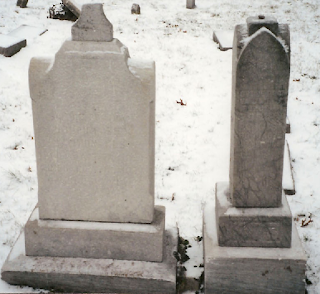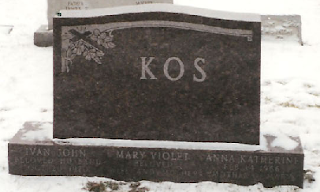Originally published on genealogyatheart.blogspot.com on 16 Jul 2015.
Like so many immigrant families, I heard the story that our family name was changed at Ellis Island. Our story, however, did not blame the officials. Supposedly, upon emigrating, my Great Grandfather, Joseph Kos, was told that his last name was awfully short for an American name. No one suggested that a short name was wrong or bad. It was just a benign comment. I figure the Ellis Island clerk was probably glad to finally get a short name he could clearly understand to record but it did not sit well with my Great Grandfather. He wanted to be an American and if the name was too short then he would make it bigger, just like America! He could do that by simply adding an “s.” The pronunciation would then change from the long o sound, that rhymed with dose, to the short o sound, that rhymed with Ross. The seed was planted to grow from Kos to Koss.
Last year, a 2nd cousin emailed me to discuss his belief that the Ellis Island story was not correct and that my grandmother, Non, was really the one behind the name change. His reasoning was that Non’s sister, his mother, Barbara, who was born in the U.S. on the 19 September 1914 has Kos as her name on her birth certificate and the parents’ names are both listed as Kos. Barbara was born 4 years AFTER our Great Grandfather emigrated so there is no reason why he would have recorded his daughter’s name with the original spelling if he had changed his name upon his arrival in the U.S. Non assimilated into the American culture the quickest and was the family matriarch so those factors supported my cousin’s reasoning.
 |
| Birth Certificate of Non’s sister, Barbara Kos, born in Chicago. |
I looked at the ship manifest for Joseph Kos who arrived in New York City on La Lorraine on 17 Jan 1910:
 |
| Ship Manifest from La Lorraine 1 |
I then looked at the 1910 Census where his name now appears more Americanized as Joseph but his last name remains Kos:On the manifest he is listed as Josip Kos. An error was made in recording his wife’s name – it was duplicated from the entry above him instead of listing his wife, Anna’s name.
 |
| 1910 Census for Joseph Kos 2 |
Joseph was working for the railroad, and at the time of the census, was in Chardon, Ohio. Next I decided to investigate the manifest for Joseph’s wife, daughter and son who did not emigrate until 3 1/2 years after Joseph. Below is the manifest for Non, listed as Mara, her mother, Jana (Anna), and her brother, Joseph Jr. (Josip), from the President Lincoln that arrived in New York City on the 16 July 1913. The last name is clearly Kos.
 |
| Ship Manifest from the President Lincoln 3 |
I know that when Non and Gramps were married on the 28 January 1917 in Chicago, Illinois both of their names appeared on the records with the added “s” as “Koss.” As distant cousins from the old country, both had the last name Kos(s) so Non’s maiden name was the same as her married name.
 |
| See the 10th from bottom – John and Mary Koss 4 |
There are 3 possibilities as to why Kos became Koss between 1914 and 1917:
1) the marriage license was an error, There are 3 possibilities as to why Kos became Koss between 1914 and 1917:
2) my great grandfather or another family member added the “s” after 1914 or
3) maybe the Ellis Island story was told about my Gramps and not my Non’s side.
I checked the ship manifest for Gramps, Ivan “John” Kos who arrived in New York City on the 6 April 1909 with his brother, Janko (Stephen) Kos:
 |
| Ship Manifest from La Gascogne 5 |
The manifest shows Kos. Next record to check is the 1910 Census. Gramps is shown as a boarder living in Bethlehem, Pennsylvania. His brother, who had left a wife behind in Croatia, had returned to her. Gramps is still shown as Kos.
 |
| 1910 Census 6 |
So the Ellis Island story wasn’t about Gramps, either. I have no family documentation between my Great Aunt Barbara’s birth in September 1914 and my Grandparents’ wedding in January 1917 so I can’t pinpoint when the last name changed or who changed it.
The family continued to use Koss after the wedding. My mother and her siblings were born at home so I do not have a birth certificate for them; a delayed certificate was never issued, either. I do have a Baptism Certificate, however, it was a copy of the lost original made when she was an adult. Born and baptized in 1918, my mother and her parents’ names are recorded as Koss.
 |
| My Mother’s Baptism Certificate – Copy of the Original |
The death index for my Great Grandfather in January 1919 has his last name as Koss but since he was dead, he didn’t provide his own name. The informant on the death certificate was Non since she was the eldest of his three children, the most educated, and with a distraught mother, Non would have been the most rational at the time. Did she use Koss because that was the name she and her husband were using or was it because her father was also using Koss?
 |
| Indiana Death Record Index 7 |
Yet his tombstone in Oak Hill Cemetery in Gary, Indiana is etched as Kos and according to cemetery records, Non and Gramps were the ones who purchased the stone.
 |
| See stone on right – 2nd from bottom
Photo by Lori Samuelson December 2001 |
The inscription is in Croatian so possibly the decision to engrave the original spelling was in keeping with that is how the name was first spelled in his birth language.
In 1920, the family reverts to using the original spelling of Kos:
 |
| 1920 Census 8 |
The 1920 census is the last paper record with the original spelling. I have no idea why they returned to using it in 1920. Perhaps they never spelled it for the census taker but instead pronounced it in the original way, with a long o sound. If that was the case, though, I would think the census taker would have spelled it Kose and not Kos.
The record below is a scan of a textbook the family purchased for school use in the 1920’s. It was passed from child to child and they each wrote their own name inside the cover. All were spelled Koss.
 |
| Textbook from 1922 |
By 1930, the name is Koss:
 |
| 1930 Census 9 |
In 1940, the name is Koss but is misspelled as Kolls:
 |
| 1940 Census 10 |
You’d think that was the end of the story but the saga continued…Both of my Grandparent’s used Koss when they became naturalized citizens in the 1940’s and that is what was on their Social Security Cards and death certificates.
Note in the textbook above that the top name on the left is George Koss. When Uncle George served in the Marines during World War II he told his Sargent about the name change at Ellis Island (that we now know didn’t happen). The Sargent told George that happened in his family, too, but the Sargent had decided it wasn’t right so he went back to using whatever the original family spelling was. He told George he would have dog tags reissued with the original name if he was interested. George decided that was the right thing to to do so George Koss became George Kos til his dying day.
 |
| WW II Muster Rolls 11 |
Since George was the only son the original family name was restored and continued down the line. My Grandparents’ and my Non’s brother are the only ones to use Koss through the rest of their lives. Check out my Grandparents’ gravestone at Oak Hill Cemetery in Gary, Indiana:
 |
| Photo by Lori Samuelson December 2001 |
When my Great Grandmother was to be buried, 3 plots were purchased. Going back to their roots, the original name was engraved. So much for
1 Year: 1910; Arrival: New York, New York; Microfilm Serial: T715, 1897-1957; Microfilm Roll: Roll 1400; Line:17; Page Number: 105
2 Year: 1910; Census Place: Chardon, Geauga, Ohio; Roll: T624_1185; Page: 16B; Enumeration District: 0056; FHL microfilm: 1375198
3 Year: 1913; Arrival: New York, New York; Microfilm Serial: T715, 1897-1957; Microfilm Roll: Roll 2130; Line:24; Page Number: 149
4 Ancestry.com. Cook County, Illinois Marriage Indexes, 1912-1942 [database on-line]. Provo, UT, USA: Ancestry.com Operations, Inc., 2011. Original data: Private donor.
5 Year: 1909; Arrival: New York, New York; Microfilm Serial: T715, 1897-1957; Microfilm Roll: Roll 1234; Line:2; Page Number: 178Ancestry.com. Cook County, Illinois Marriage Indexes, 1912-1942 [database on-line]. Provo, UT, USA: Ancestry.com Operations, Inc., 2011. Original data: Private donor.
6 Year: 1910; Census Place: Pittsburgh Ward 21, Allegheny, Pennsylvania; Roll: T624_1307; Page: 3B; Enumeration District: 0573; FHL microfilm: 1375320
7 Indiana Death Index
8 Year: 1920; Census Place: Gary Ward 5, Lake, Indiana; Roll: T625_446; Page: 24A; Enumeration District:111; Image: 889
9 Year: 1930; Census Place: Gary, Lake, Indiana; Roll: 600; Page: 4B; Enumeration District: 0058; Image:242.0; FHL microfilm: 2340335
10 Year: 1940; Census Place: Gary, Lake, Indiana; Roll: T627_1121; Page: 8A; Enumeration District: 95-83
11 Ancestry.com. U.S. Marine Corps Muster Rolls, 1798-1958 [database on-line]. Provo, UT, USA: Ancestry.com Operations Inc, 2007.







































